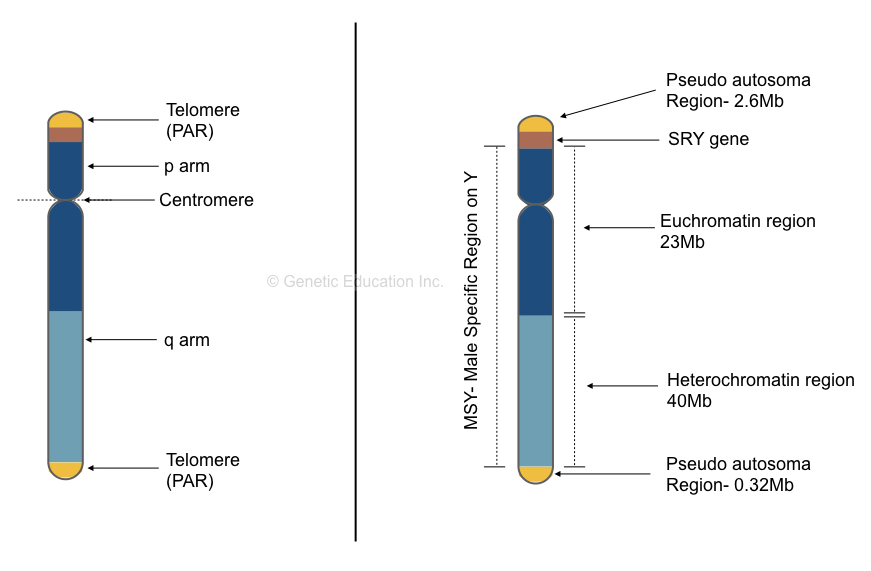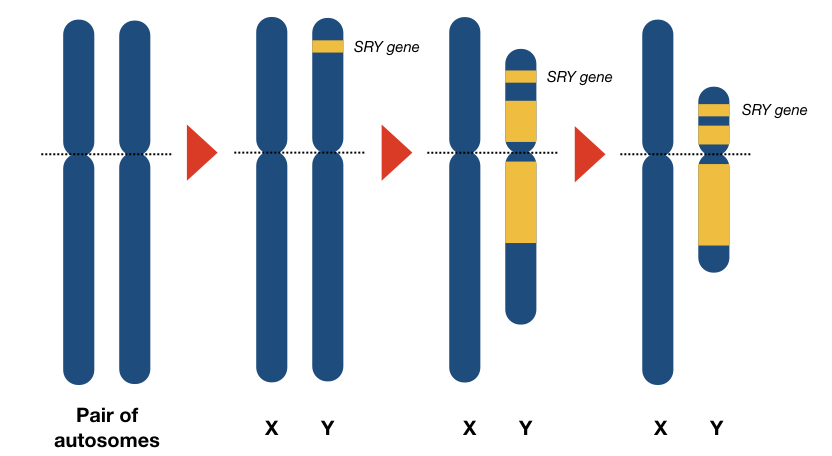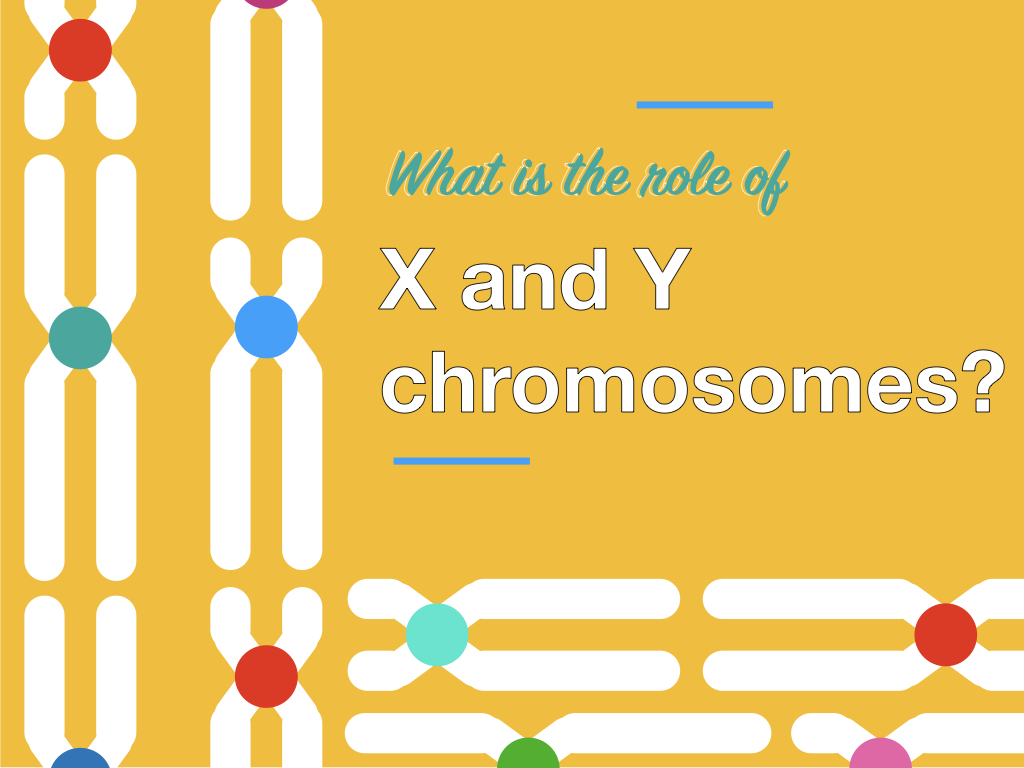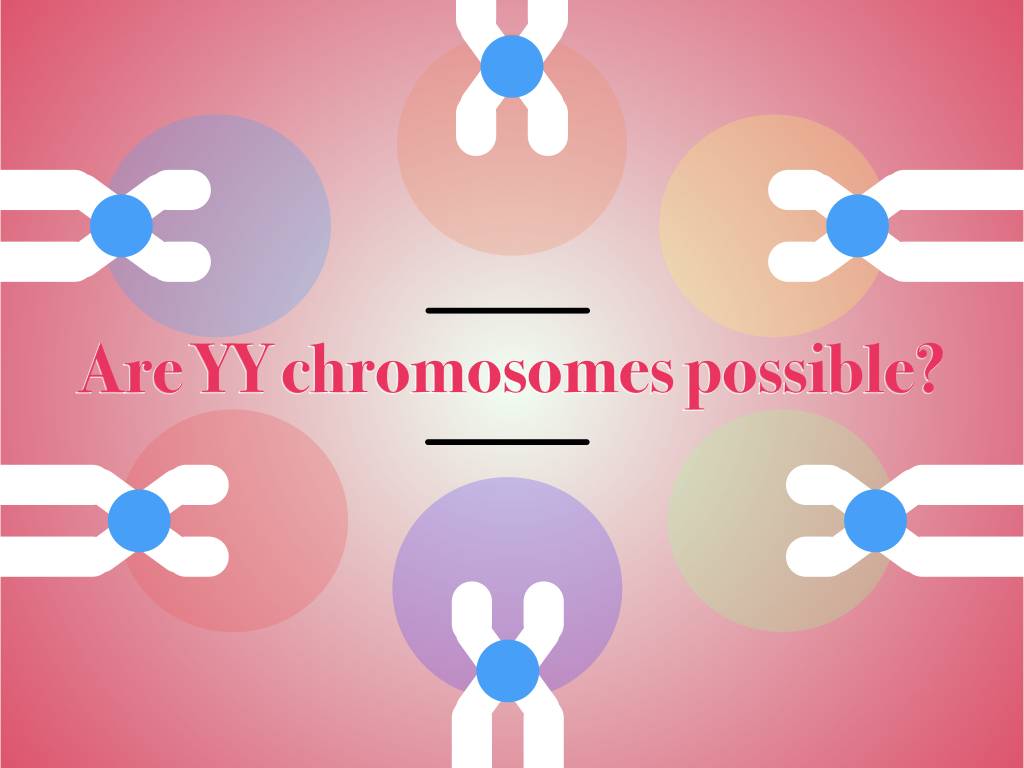A single copy of the Y chromosome, dosage-sensitive gene sets and lack of recombination event may result in a genetic degeneration timely on the Y chromosome, possibly going extinct in the future, researchers suggest.
Related article: Are YY Chromosomes Possible?
The question on the existence of the Y chromosome parted scientific fraternity into separate opinions, one group says it will remain while the other says it will go soon.
Let’s find out what the truth is!
It has been proven that the Y chromosome has degenerated timely but the question is is it over or will it continue? In order to understand the present hypothesis, we need to acknowledge its structural and functional importance.
Y chromosome- Structure and function:
The Y chromosome has been an attention seeker as it differs in structure and function. It’s a tiny Y-like chromosome and so labeled as the Y chromosome. Structurally is one of the smallest chromosomes.

Functionally, has been known for its proven role in sex determination. The Y chromosome is a unique identity of human male individuals on the earth. The reason behind that is that its content- ‘genes’ that are involved in reproductive development such as testis development and production of male hormones etc.
Though being remains tiny the major part has heterochromatin content- ‘gene-less regions’. However, largely the gene-rich portion is categorized as MSY– a male-specific region on Y.
A gene, known as SRY– a sex-determining region on the Y has been investigated as an important gene for maleness. You know what I mean by maleness- primary and secondary sexual characteristics.
But the SRY gene isn’t a topic of debate for the present article so we will leave it here and go ahead.
Structurally, the Y chromosome is categorized as an acrocentric chromosome with around only 63 to 78 known functional genes. The length of the Y chromosome is 57,227,415bp with a long q arm and a short p arm.
It’s a tiny chromosome but wasn’t in past! The Y chromosome was separated from autosomes 188 million years ago, in fact, the X chromosome too. Until 166 million years the size of the X and Y chromosome remained the same, studies suggest.

Periodically, the Y chromosome is shriveling and gradually losing genes, the process is continued till now. But the question is which factors actually encouraged Y chromosome decay? Would it be planned or is occuring randomly?
Note:
The Y chromosome has 78 genes while the X chromosome has 800 genes.
Evolution time frame:
- Life evolved on earth 4.6 billion years ago.
- Y chromosome evolved 180 million years ago.
- Y chromosome was diverge chimpanzee lineages 3 to 4 million years ago.
- The Y chromosome is similar in length to the X chromosome to 166 million years ago (known as proto-Y).
- The Y chromosome of the rhesus monkey separated from Humans 25 million years ago.
- Only a single gene from the Y has been lost from the human genome in the last 25 million years
- Not a single gene has been lost in the last six million years from the Y chromosome.
- The Y chromosome will disappear in 4.6 million years.
Possible reasons for the Y chromosome disappearing
The unpaired Y chromosome, lack of recombination, events of inversions and lack of gene duplications are several well-studied factors for Y chromosome shortening.
Let’s discuss each factor separately.
Autosomes and sex chromosomes are two categories human chromosomes are broadly divided. Among 46 total numbers of chromosomes, X and Y are considered as allosomes or sex chromosomes.
Females have a pair of X chromosomes (XX) while males have one X and one Y chromosome (XY). Hypothetically, though one of the X chromosomes is inactivated, it’s a backup for one another.
But that’s not the case with the Y, because it is alone, so if some sequences it lost, are lost forever.
Yet another well-studied and proven factor in this scenario is the lack of recombination events. The recombination events produce various gene combinations and exchange genetic material.
Put simply, recombination between two homologous chromosomes helps a genome in many ways. It exchanges genetic material between paternal and maternal chromosomes, produces different combinations of alleles and copies genes between chromosomes.
But unfortunately, the Y chromosome doesn’t recombine because it is alone. For example, two X chromosomes recombined, take advantage of the process, but a single Y can’t!
Nonetheless, my research explained that it’s partly true. Some recombination may occur between the male X and Y chromosomes.
Paracentric and pericentric inversion has been known reason besides lack of recombination that cause Y decay. Inversion is simply understood as deletion and reinsertion of the same part in inverted orientation. If inversion causes chromosomal rearrangement mutation, it can’t be retained later on.
Gene duplication is another factor perhaps required for genes on the Y chromosome to duplicate and retain. Unequal crossing over between non-homologous chromosomes during meiosis leads to gene duplication, often.
However, it isn’t reported on the Y chromosome and therefore no backup copies of genes are found or inherited.
Moreover, telomere shortening, a well understood and studied mechanism involved in losing DNA sequences from telomere is also there on the Y chromosome which further shrinks the Y chromosome.
These all factors collectively support the evidence that the Y chromosome losing DNA sequences. Nonetheless, the Y chromosome is very crucial for males at least, the reason is that the SRY and MSY gene regions that are there which has significant importance in maleness.
Natural selection preserved SRY and relevant genes therefore maleness remained intact. But the question is how and why it has been preserved.
The reason why some vital genes are conserved since evolution is also favored by the process of recombination. Though X and Y chromosomes aren’t homologous, a specific region present on both chromosomes known as PAR- pseudoautosomal region makes it possible for some genes.
PAR between X and Y chromosomes behaves like homologous regions, gets recombined and exchanges genetic material. The SRY gene region, neighbors to PAR, sometimes take part in recombination.
Other essential sequences get retention by their ‘nature of Palindromic’ and gene amplification. The palindromic nature of several sequences (which are similar in structure on both sides); acquires the gene duplication process.
On the other side, amplification also “Copy/Past” vital genes. These mechanisms prevent genes on the Y chromosome to disappear that’s why they are there for millions of years.
Will the Y chromosome really disappear?
Many studies and discussions are going on on this topic, some researchers are in its favor and some are not. Research suggests that seeing its pace of losing genes the Y chromosome will disappear in 4.6 million years.
It is not much time if we compare it with the existence of life on earth. However, Dr. Hughes said that the Y chromosome decay is at its end and the genes remain will remain forever.
Griffith DK (2012) published a conversation between Graves J and Hughes J at the 18th Internation Chromosome Conference in Manchester 2021 explaining the arguments on both sides.
Jenny Graves was on the side of Y degradation and said that it will continue while Jenn Hughes was on the side of Y retention and said that it will remain on earth. The main argument between both is summarised here.
Jenny Graves strongly explained that “the Y chromosome is degraded in other organisms and continue in human as well, studies on vertebrates, invertebrates and plant by Muller (1914) suggest.”
Contrary Jenn Hughes explained that “the degradation achieved a point of equilibrium and can’t go further, genes remained will remain forever.”
They also explained Ohno’s hypothesis which demonstrates an overwhelmingly new concept that the Y chromosome is a degraded form of the X. The hypothesis is true to some extend.
Previous research suggests that the Y chromosome was derived from the X and had equal length. So was identical to the X, unfortunately, over time it diminished in length.
As of now, we can’t support either scientific fact but the Y chromosome has much more time before decay; we don’t know what nature offer us in the future (before 4.5 million years).
Can men live without the Y chromosome?
The arguments raised another crucial question and that must be answered, “can men live without the Y chromosome? What if the Y will really disappear?
See, there are no clear scientific research around it but theories and some research outcomes suggest that the highly conserved regions, the PAR along with the SRY and other important genes will remain on Y.
If not, as the PAR behaves like the autosomal region, it can recombine with the X and can migrate there. In my research work, I have reported a few cases of sex reversal which explains that recombination migrates SRY along with the PAR and related genes to X, male-specific secondary and primary sex characters are observed.
However, individuals aren’t fully male. So genetically they were XX male (with SRY) but phenotypically are more female with abnormal genitalia.
Henceforth the answer to this question is “Yes”; if all will remain well, purifying selection will occur and “brain and balls genes” will land safely on the X chromosome or any other autosome, men can live without the Y in the future.
Read more: Importance of Metaphase Chromosomes in Karyotyping.
Wrapping up:
Sex chromosomes are mysterious. The Y though is a debatable suspect, the X chromosome also has fascinating approaches. The presence of two X chromosomes doubles the X-linked gene expression, which is also not a suitable condition.
A mechanism called X-chromosome inactivation makes an entire single X chromosome inactive genetically. And consequently, balance gene expression.
Contrary to that, the fate of the Y chromosome is still unknown, however, studies and models suggest the heterochromatin region of the Y is continuously losing DNA sequences that’s the sign the Y may die soon.
Sources:
Wilson, J., Staley, J.M. & Wyckoff, G.J. Extinction of chromosomes due to specialization is a universal occurrence. Sci Rep 10, 2170 (2020). https://doi.org/10.1038/s41598-020-58997-2.
Griffin, D.K. Is the Y chromosome disappearing?—Both sides of the argument. Chromosome Res 20, 35–45 (2012). https://doi.org/10.1007/s10577-011-9252-1.


